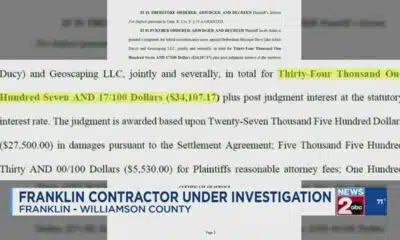News from the South - Louisiana News Feed
‘The Light Switch’ Episode 6: Kratom collision course
by Louisiana Illuminator, Louisiana Illuminator
May 16, 2025
You might have heard of kratom – but it’s more likely you’ve seen it, or at least the word – written in neon on the front of a smoke shop — or on a little bottle next to the checkout at a convenience store.
Technically, kratom is not a drug, but some people use it like one. In many cases, they’re using it to help them get off of drugs, like highly addictive opioids.
But there are other kratom stories, and they don’t have happy endings.
There are two bills being debated in the Louisiana Legislature – one seeks to ban kratom entirely, and the other would regulate how it’s packaged and sold, keeping it available for people who say it’s changed their lives for the better.
In this episode, Illuminator editor Greg LaRose explores both sides of the kratom issue. You’ll hear from the people it affects, good and bad and explore the science behind substance and the disputes over it.
Plus, we’ll chip away at the misinformation that surrounds the political debate – here in Louisiana and in other states that have chosen to regulate, ban and un-ban the substance.
How to listen:
Please subscribe and rate The Light Switch on Spotify or Apple.
Louisiana Illuminator is part of States Newsroom, a nonprofit news network supported by grants and a coalition of donors as a 501c(3) public charity. Louisiana Illuminator maintains editorial independence. Contact Editor Greg LaRose for questions: info@lailluminator.com.
The post ‘The Light Switch’ Episode 6: Kratom collision course appeared first on lailluminator.com
Note: The following A.I. based commentary is not part of the original article, reproduced above, but is offered in the hopes that it will promote greater media literacy and critical thinking, by making any potential bias more visible to the reader –Staff Editor.
Political Bias Rating: Centrist
The content presents a neutral exploration of the kratom debate, examining both sides of the issue without expressing a strong ideological stance. It highlights the contrasting perspectives regarding kratom’s regulation, mentioning both the arguments for banning it and those for keeping it available. The inclusion of voices from individuals who have benefited from kratom, as well as those who have experienced negative consequences, suggests a balanced approach. Additionally, the mention of misinformation around the debate indicates an attempt to address a complex issue without taking a particular political side.
.
News from the South - Louisiana News Feed
Monday Noon Tropics Update: Fernand heads north, Invest 99 fizzles
SUMMARY: Tropical Storm Fernand is improving in organization with 60 MPH winds but faces increasing wind shear and cooler waters as it moves north, likely weakening by Wednesday without threatening land. Invest 99 in the eastern Caribbean remains disorganized with strong wind shear, leading the National Hurricane Center to drop its development chance to 0%. The hurricane season has reached Fernand, with Gabrielle and Humberto next on the list, though no new formations are expected soon. Approaching the peak hurricane season around September 10, activity is likely to continue through September, with cooling temperatures and increased rain chance as fall approaches.
Meteorologist Alexandra Cranford tracks Tropical Storm Fernand and Invest 99 at noon on Monday, August 25, 2025.
News from the South - Louisiana News Feed
Fox 14 Your Morning News: Movement Monday
SUMMARY: Fox 14 Your Morning News’ Movement Monday features partner exercises focused on fun and fitness. The segment includes reverse lunges, one-legged squats, and partner high-five squats to build strength and balance. They use a ball or pillow for back-to-back seated twists and tossing exercises to engage the core. The workout ramps up with side-to-side knee kicks and ab work to boost abdominal strength. Lastly, partners perform planks combined with cardio moves like jumping through feet, emphasizing proper form, breathing, and rhythm to maximize calorie burn and stability. The lively, encouraging approach makes fitness enjoyable and accessible.
Amy returns for another lively installment of ‘Movement Monday,’ which includes a variety of exercises such as reverse lunges, one-legged squats, and planks, all aimed at promoting fitness and teamwork.
News from the South - Louisiana News Feed
Extreme heat in prisons brings more legal challenges, pressure on states
by Amanda Hernández, Louisiana Illuminator
August 25, 2025
Summer heat is bearing down on U.S. prisons, where temperatures in uncooled cells can climb well into the triple digits.
Facing growing pressure from advocacy groups, lawsuits and climate projections that show hotter days ahead, some state prison systems are moving to install air conditioning and expand cooling measures — though many facilities remain years away from significant upgrades.
But in other states, such efforts have stalled or failed. That may lead to more lawsuits in the future, experts say, even as judges may raise the bar for such cases.
An emphasis on being “tough on crime” and prioritizing other public safety measures may have contributed to less attention on prison conditions in some states. In others, slowing revenue growth and pressure to rein in corrections spending could be making new investments a harder sell.
At least two states this year, Virginia and Texas, considered legislation addressing excessive heat in prisons but neither measure became law. The Texas bill would have required the state Department of Criminal Justice to purchase and install climate control systems in all of its facilities by the end of 2032. About two-thirds of the state’s correctional facilities have only partial or no air conditioning.
The measure passed the House but did not advance in the Senate before the legislature adjourned in June.
GET THE MORNING HEADLINES.
In Virginia, lawmakers approved a bill that would have required the state corrections department to install heat and air conditioning in its prisons and to ensure cell temperatures not exceed 80 degrees. Republican Gov. Glenn Youngkin vetoed it, citing the cost of installation and operational burdens. Youngkin also wrote that existing state corrections data “does not substantiate the claims of extreme temperatures or health risks.”
But in Delaware, the fiscal year 2026 capital budget approved last month includes $2 million in funding to install air conditioning at the James T. Vaughn Correctional Center.
These changes mark the latest actions in a long-running debate over how correctional systems respond to rising summer temperatures — an issue that affects both incarcerated people and staff. Some of the policy debates and facility updates this year follow years of advocacy and litigation over the health, safety and operational challenges posed by heat in correctional settings.
The problem of excessive heat in prisons has persisted for decades and has unfolded alongside other challenges, including chronic understaffing and overcrowding. In some cases, these problems have led to extended facility lockdowns, even during the summer months.
“There are people working in prisons and they have the right to work in climates that are comfortable,” said Nancy La Vigne, a criminal justice researcher and dean of the School of Criminal Justice at Rutgers University. “When they’re not, there’s retention issues, and it’s hard to replace staff. And when you don’t replace staff, then you have challenges in maintaining the safety and security of the facility.”
In New York, for example, correctional officers staged a three-week strike earlier this year and many didn’t return to work. Some facilities now are operating with 30%-60% fewer guards than needed, resulting in some incarcerated people getting only an hour or two outside of their cells each day.
A 2023 study published in the peer-reviewed PLOS One journal found that mortality in state and private prisons rose during periods of extreme heat, with deaths increasing 3.5% on extreme heat days and up to 7.4% during three-day heat waves. Between 2001 and 2019, nearly 13,000 people died in prison during the summer months, almost half of them in the South, though the study did not determine how many of those deaths were directly attributable to heat.
Climate change is fueling longer, more intense periods of extreme heat. Exposure to extreme heat can worsen conditions such as cardiovascular disease, diabetes and asthma, and has also been linked to worsening mental health and higher suicide rates among incarcerated people.
“Average temperatures are rising, and you’re going to have more and more states around the country where incarcerated people are held in conditions that are not livable because they’re too hot,” said Sharon Dolovich, a law professor and director of the Prison Law and Policy Program at the University of California, Los Angeles.
Some upgrades
At least 44 states lack universal air conditioning within their prison facilities, even in regions known for sweltering summer temperatures, according to a 2022 USA Today analysis. A recent Reuters investigation also found that nearly half of state prisons across 29 states have partial or no air conditioning in housing units.
But some states are investing millions to update their prison facilities.
In North Carolina, corrections officials are working toward their goal of installing air conditioning in all 54 state prisons by 2026. To date, 33 facilities are fully air-conditioned, 17 are partially air-conditioned, and four have no air conditioning, according to its dashboard.
In California, the Department of Corrections and Rehabilitation, which operates 31 adult prisons, has spent $246 million in the past five years on cooling improvements at five prisons, according to a department spokesperson.
Lawmakers this year also approved funding for the Air Cooling Pilot Program at three facilities, with $17.6 million allocated for fiscal years 2025-26 and $20 million for fiscal years 2026-27. It will evaluate the effectiveness of two alternatives prior to a statewide plan to address high indoor temperatures across the California prison system.
The Texas Department of Criminal Justice, as of Aug. 1, is building 12,827 “cool beds,” or prison cells in air-conditioned units, and is in the process of procuring an additional 7,162, according to its dashboard.
Texas is one of the states most closely associated with heat-related deaths in prison. A 2022 study estimated that, on average, 14 deaths per year in Texas prisons are associated with heat. And a Texas Tribune analysis found that at least 41 incarcerated people died during a record-breaking heat wave in 2023.
In March, a federal judge ruled the extreme heat in Texas prisons is “plainly unconstitutional,” but declined to order immediate air conditioning, saying the work could not be completed within the court order’s 90-day window and temporary systems might delay a permanent fix.
‘More miserable’
Sweltering summer heat can turn prisons into pressure cookers. People inside already may have health conditions, limited access to cooling, or take medications that make it harder for their bodies to handle the heat. And research suggests that high temperatures can heighten irritability and aggression, sometimes fueling more conflicts between incarcerated people or with staff.
“It makes you more miserable. … If you to the point of even thinking about suicide, that’s just going to add to it,” said Ronald McKeithen, who spent 37 years incarcerated in Alabama prisons and is now the director of second chances at the Alabama Appleseed Center for Law and Justice. McKeithen recalls feeling “on edge” due to tension among other incarcerated people on hot days.
At the Oshkosh Correctional Institution in Wisconsin, Devin Skrzypchak said the heat worsens his bladder condition, and he often can’t get the incontinence briefs he needs. The heat forces him to drink more water, and on days when ice isn’t available, he’s left drenched in sweat.
“At times, it’s a living hell. … It can be very excruciating,” Skrzypchak wrote in a message to Stateline through the facility’s messaging platform.
D’Angelo Lee Komanekin — who has spent about 25 years in and out of different Wisconsin corrections facilities — said prison architecture plays a major role in why temperatures inside climb so high.
“The planet is getting hotter and hotter,” said Komanekin, who relies on a small plastic fan to stay cool. Komanekin also is incarcerated at the Oshkosh Correctional Institution. “They’re doing nothing about the architecture. Some institutions’ windows open, some don’t, but most of the doors have steel doors with trap doors.”
Older prison designs that rely heavily on steel and concrete building materials often trap heat, making it difficult to keep temperatures down in the summer. Aging facilities also are less likely to be equipped for the installation of central air conditioning.
Some state prison systems, including Alabama’s and Wisconsin’s, are adding air-conditioning or air-tempering systems to new prison construction and major renovation projects.
Future legal battles
Legal experts say the issue of excessive heat in prisons is likely to become more pressing as climate change drives longer and hotter summers.
Extreme heat in correctional facilities has already been the subject of litigation in dozens of states, with plaintiffs arguing that high temperatures constitute cruel and unusual punishment under the Eighth Amendment. Court rulings in these cases have varied, but some experts say even more lawsuits are likely if facilities do not adapt.
“The conditions are going to worsen. [Incarcerated people are] going to be looking for every possible avenue for assistance they can,” Dolovich, the UCLA law professor, told Stateline.
One of the latest cases comes from Missouri, where the nonprofit law firm MacArthur Justice Center filed a class-action lawsuit in May on behalf of six incarcerated people at Algoa Correctional Center.
The lawsuit alleges that the conditions violate their constitutional rights under the Eighth Amendment. It seeks to require the Missouri Department of Corrections to work with experts to develop a heat mitigation plan that keeps housing unit temperatures between 65 and 85 degrees. If the department cannot meet that standard, the plaintiffs are asking for the release of three of the incarcerated people who have less than a year remaining on their sentences.
Lawsuits such as the Missouri case often focus on claims that extreme heat worsens existing medical problems. To proceed, they must meet two legal requirements: proving the heat poses a serious health or safety risk, and showing prison officials knew about the danger but failed to address it, according to Dolovich, whose work has focused on the Eighth Amendment and prison conditions.
Courts may also raise the bar for proving such claims if judges echo decisions in cases with similar Eight Amendment arguments related to the death penalty and homelessness, Dolovich said. Judges have shifted, she said, toward a “superadding terror, pain and disgrace” standard under the Eighth Amendment — a higher threshold requiring proof that conditions were created with the intent to cause unnecessary suffering.
Dolovich added that some recent court decisions have provided only narrow remedies, such as ordering ice and fans instead of installing air conditioning.
“Prison officials have a moral and a constitutional responsibility to respond to changing conditions. In this case, it means air conditioning. … Anything less than that, to me, is indefensible.” she said.
Stateline reporter Amanda Hernández can be reached at ahernandez@stateline.org.
YOU MAKE OUR WORK POSSIBLE.
This report was originally published by Stateline, part of the States Newsroom nonprofit news network. It’s supported by grants and a coalition of donors as a 501c(3) public charity. Stateline maintains editorial independence. Contact Editor Scott S. Greenberger for questions: info@stateline.org.
Louisiana Illuminator is part of States Newsroom, a nonprofit news network supported by grants and a coalition of donors as a 501c(3) public charity. Louisiana Illuminator maintains editorial independence. Contact Editor Greg LaRose for questions: info@lailluminator.com.
The post Extreme heat in prisons brings more legal challenges, pressure on states appeared first on lailluminator.com
Note: The following A.I. based commentary is not part of the original article, reproduced above, but is offered in the hopes that it will promote greater media literacy and critical thinking, by making any potential bias more visible to the reader –Staff Editor.
Political Bias Rating: Center-Left
This article focuses on the human and constitutional costs of inadequate climate control in U.S. prisons, highlighting health risks, lawsuits, and advocacy efforts for improved conditions. It presents facts and critiques the failure of some states, particularly those with conservative leadership, to act on air conditioning installation, framing these failures in terms of moral responsibility and human rights. While it remains largely factual and balanced, the emphasis on systemic issues within prisons, climate change impact, and critiques of financial and political obstacles—especially mentioning vetoes by Republican governors—indicates a center-left leaning perspective, which tends to prioritize social justice, human rights, and governmental intervention to address public welfare challenges.
-
News from the South - Alabama News Feed7 days ago
U.S. agriculture secretary announces end to subsidies for solar panels on farmland
-
News from the South - Kentucky News Feed6 days ago
First of its kind clinical trial offers new hope for Kentuckians at risk of dementia
-
News from the South - Georgia News Feed7 days ago
Don't eat this shrimp sold at Walmart due to possible radiation contamination: FDA
-
News from the South - Arkansas News Feed7 days ago
Cities across the US are embracing AI guidelines for local government workers
-
Our Mississippi Home6 days ago
MSU Unveils Mixed-Use Development Featuring Boutique Hotel, Cultural Landmark
-
News from the South - Arkansas News Feed6 days ago
‘Alligator Alcatraz’ probed by Dems as ICE detention centers multiply in states
-
News from the South - Alabama News Feed6 days ago
Grants to boost local emergency alert systems in question as public media agency closes
-
News from the South - Arkansas News Feed5 days ago
New I-55 bridge between Arkansas, Tennessee named after region’s three ‘Kings’












































